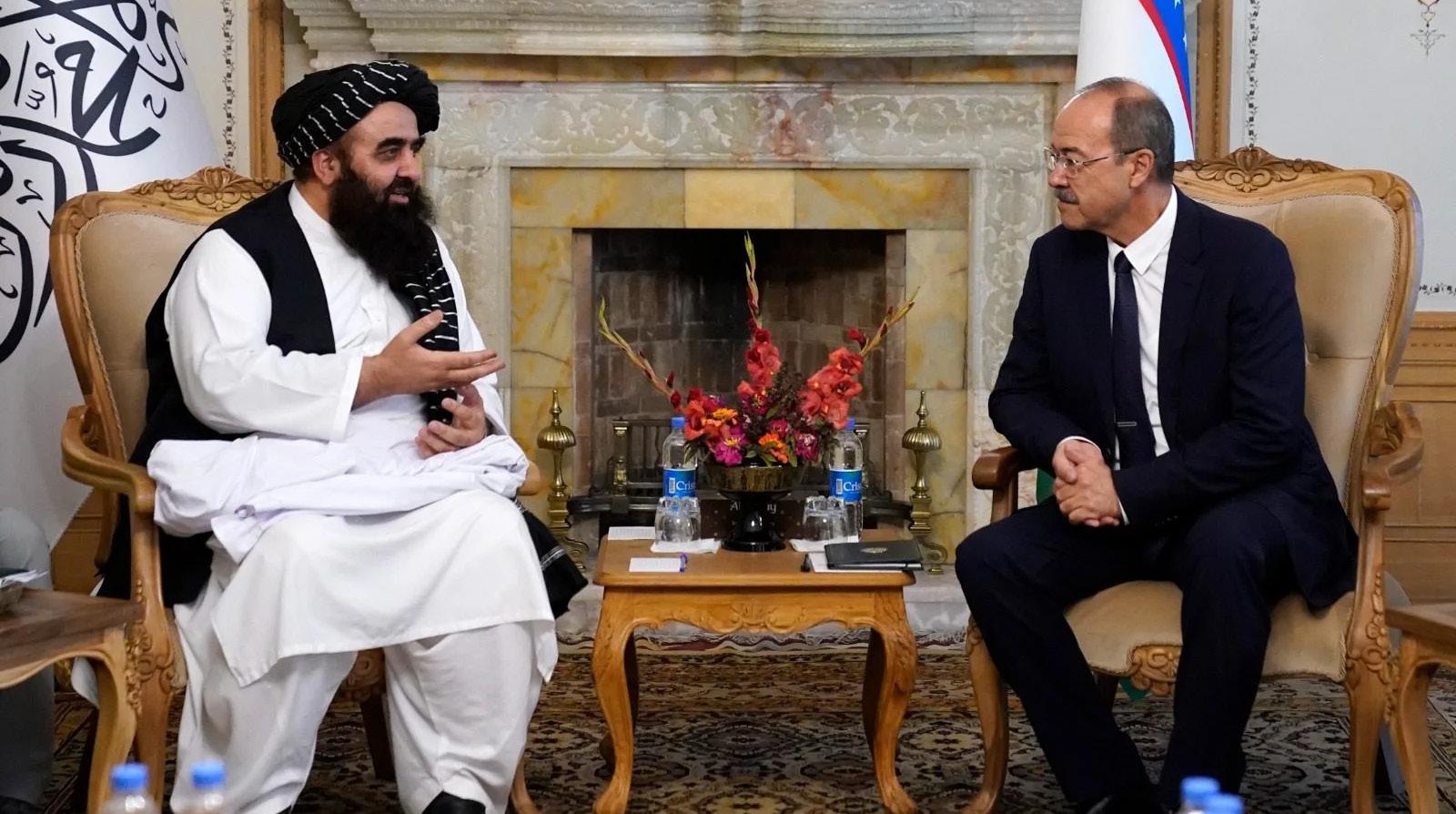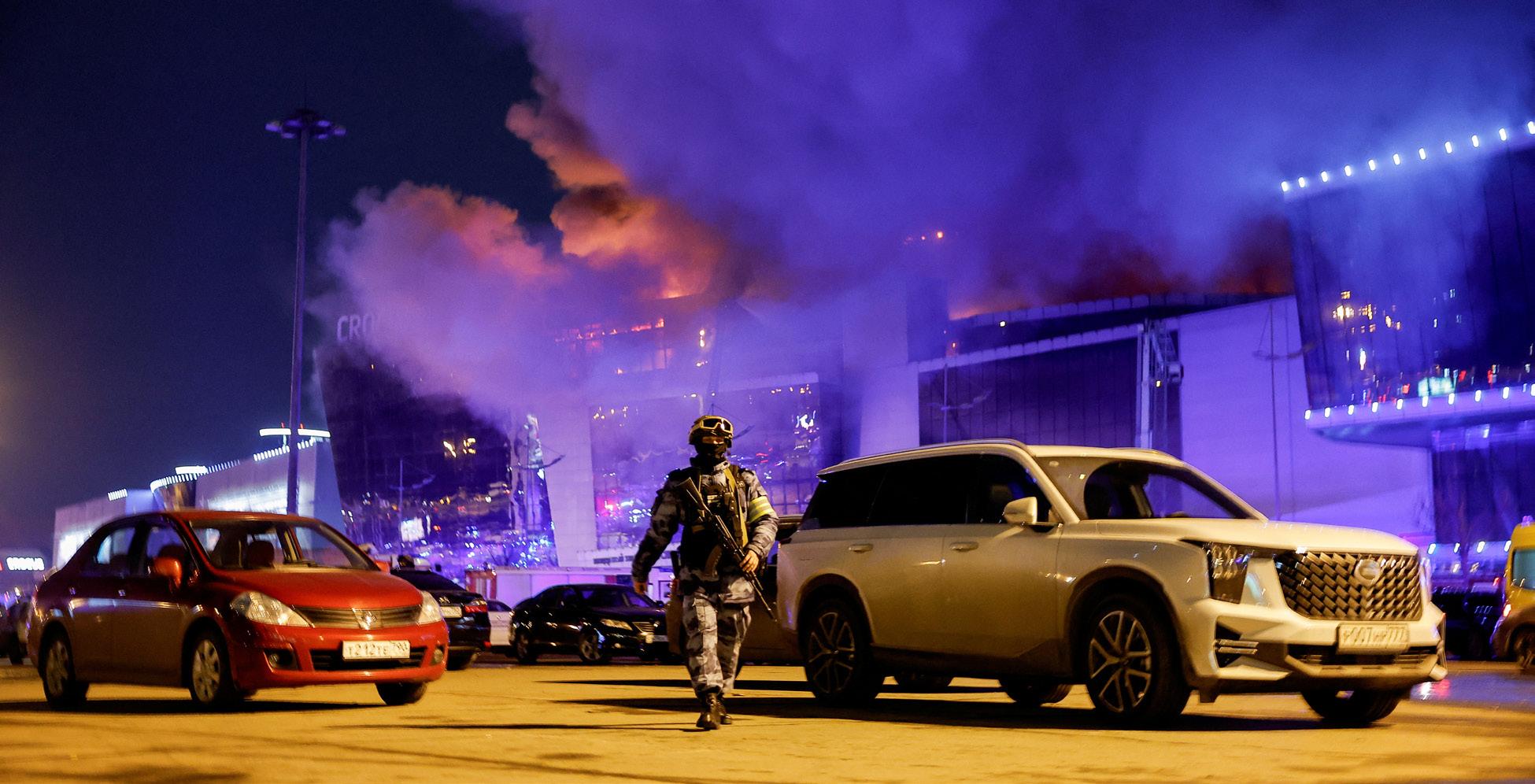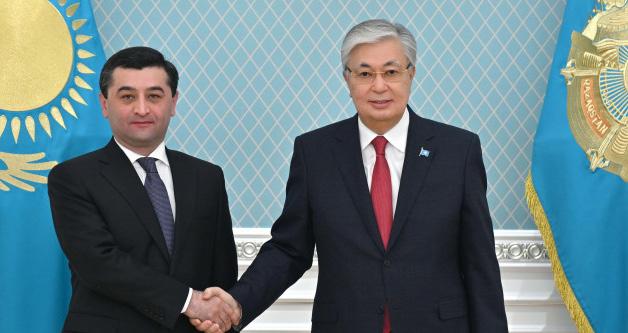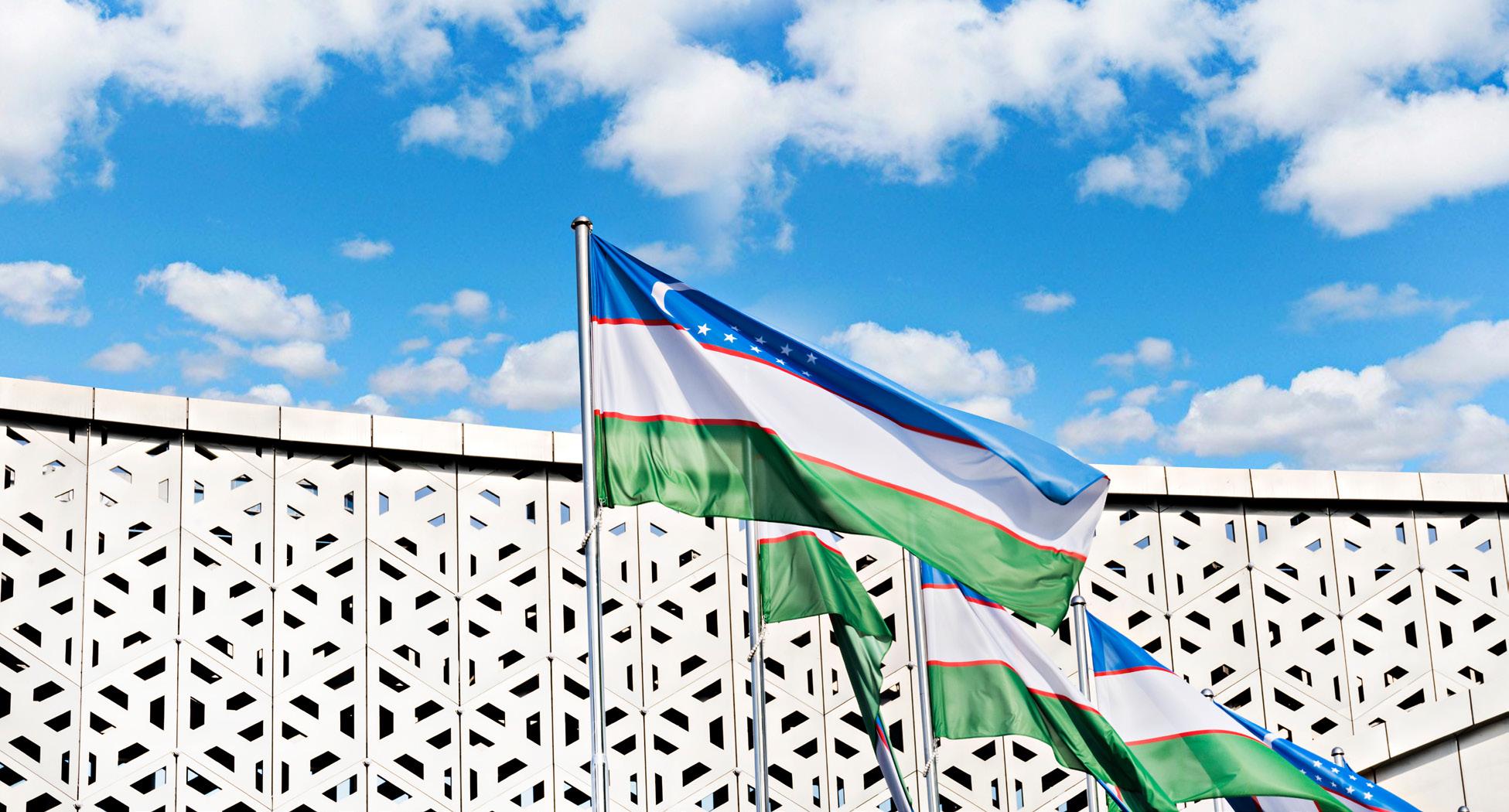In Central Asia
Bruce Pannier






COUNTERING A “GREAT JIHAD” IN CENTRAL ASIA
Bruce Pannier
All rights reserved. Printed in the United States of America. No part of this publication may be reproduced or transmitted in any form or by any means, electronic or mechanical, including photocopy, recording, or any information storage and retrieval system, without permission in writing from the publisher.
The views expressed in this report are those of the author alone and do not necessarily reflect the position of the Foreign Policy Research Institute, a non-partisan organization that seeks to publish well-argued, policy-oriented articles on American foreign policy and national security priorities.
© 2024 by the Foreign Policy Research Institute
November 2024
Bruce Pannier is a Central Asia Fellow in the Eurasia Program at the Foreign Policy Research Institute and a longtime journalist and correspondent covering Central Asia. He currently writes Radio Free Europe/Radio Liberty’s blog, Qishloq Ovozi, and appears regularly on the Majlis podcast for RFE/RL. Prior to joining RFE/RL in 1997, Bruce worked at the Open Media Research Institute in Prague. In 1992, he led a sociological project in Central Asia sponsored by the University of Manchester and the Soros Cultural Initiative Foundation. During that time he lived in villages in Kazakhstan, Kyrgyzstan, Turkmenistan and Uzbekistan. Bruce studied at Tashkent State University in the summer of 1990 and studied at Columbia University under Professor Edward Allworth. Bruce has also written for The Economist, Janes Intelligence, Oxford Analytica, Freedom House, The Cairo Review, the FSU Oil & Gas Monitor, and Energo Weekly.
About the Author Eurasia Program
The Eurasia Program at the Foreign Policy Research Institute was founded in 2015 with the aim of examining the political, security, economic, and social trends shaping Europe and Eurasia. Our research agenda covers the increasingly tense competition roiling the region from several angles. It has a multi-year focus on the Baltic Sea, the Black Sea, and Central Asia, emphasizing how geography, economics, ideology, and history continue to shape politics and security in these regions. The program also publishes analyses of Russian foreign policy, including Russia’s role in Europe, Asia, Africa, and the Middle East. The Russia Political Economy Project, along with the Bear Market Brief, analyzes the linkages between Russia’s economy, society, and its political system. The Eurasia Program’s thematic initiatives also include the Democracy at Risk rubric, which examines the trends of democratization and authoritarian pushback in the region.
Introduction
Concerns about Islamic extremism are rising in Central Asia. None of the governments in Kazakhstan, Kyrgyzstan, Tajikistan, Turkmenistan, or Uzbekistan are commenting publicly about any specific threats. Still, there is a lot of activity aimed at controlling how Islam is practiced and what people say about the religion on social networks in these majority-Muslim countries. Law enforcement agencies are carrying out security operations aimed at rooting out suspected Islamic extremists in their countries, almost certainly spurred by citizens of the Central Asian states’ involvement in terrorist plots and acts outside the region. All this has happened before in Central Asia, but previous extremism or terrorism problems affected only an individual Central Asian country. Now, all five Central Asian governments are taking actions, showing that these fresh concerns are spread across the region. Though these worries are not directly connected to the Taliban, the recent commotion in Central Asia started after the Taliban returned to power in Afghanistan in mid-August 2021.
Hunting the Enemy
Within In the last half of the 1990s, the Central Asian states, except Turkmenistan, viewed the Taliban as the greatest threat to their security. The ultra-Orthodox Taliban’s ability to gather support and sweep through Afghanistan was especially alarming to the Central Asian leaders.
When the Soviet Union collapsed in late 1991, among the first acts of the governments in the newly independent Central Asian states was to lift restrictions on religious practice and remind the world that Islam was the religion of the region. This public reembrace of Islam reinforced their claim to independence from their former colonial master Russia. Central Asian countries were historically majorityMuslim, not Russian Orthodox.
The ability to freely practice Islam after more than 70 years of official atheist Soviet rule was warmly welcomed by the majority of Central Asia’s population and helped the fledging governments earn popular support.
The ability to freely practice Islam after more than 70 years of official atheist Soviet rule was warmly welcomed by the majority of Central Asia’s population and helped the fledging governments earn popular support.
The problem was and remains that the leaders of the countries know relatively little about Islam, and they probably know less than most of their citizens who are currently under 35 years of age. Most of Central Asia’s leaders were young adults when the Soviet Union disintegrated, so they were unable to attend mosques. They have no spiritual authority in the eyes of their people.
To the Central Asian leaders of the late 1990s, the Taliban represented a military threat and, perhaps more ominously, a model for using Islam to unify support and conquer a country—like what happened in Iran, Central Asia’s other southern neighbor, in 1979.

Uzbekistan (AXP Photography/Unsplash)
The Uzbek and Tajik governments aided, respectively, ethnic Uzbek and Tajik groups inside Afghanistan that were fighting against the Taliban at the gateways to Central Asia. The Taliban reciprocated by providing a haven to militants from the Islamic Movement of Uzbekistan (IMU), a group whose goal was the overthrow of Uzbekistan’s government. Operating from bases in Tajikistan’s remote mountains, the IMU staged incursions into southern Kyrgyzstan in the summer of 1999 and again in southern Kyrgyzstan and southeastern Uzbekistan in the summer of 2000. This was the only time multiple Central Asian governments simultaneously faced the same threat on their territories. After the incursions of 1999 and 2000, the IMU militants retreated into northern Afghanistan when winter arrived. The IMU stayed in Afghanistan in the summer of 2001 to join the Taliban in battling the last pockets of anti-Taliban resistance in northeastern Afghanistan. In November 2001, IMU militants suffered huge losses in US bombing, and the remnant of the group fled to the tribal areas in Pakistan.
When the Taliban openly entered Kabul in mid-August 2021, the Central Asian governments took a pragmatic position to the change of power. All the Central Asian governments, except the Tajik government, were in contact with Taliban officials shortly after Kabul fell. Connections between Afghanistan and Central Asia—roads, railways, and, importantly, power transmission lines bringing electricity from Central Asia to Afghanistan—had expanded greatly in the 20 years the Taliban were not in power. There was much to be gained for all parties in reaching an amicable understanding.
For their part, the Taliban pledged not to allow any group to use Afghan territory to plot or carry out an attack against neighboring countries. This offered some comfort to the Central Asian governments who remembered the IMU insurgencies of 1999 and 2000 and were concerned about the presence of Central Asian citizens in several of the militant groups still inside Afghanistan.
One of those groups is the Islamic State of
Khorasan (ISK), which includes in its ranks citizens of Central Asia. In April 2022, ISK militants fired at least 10 rockets from northern Afghanistan toward the Uzbek border city of Termez.1 Most of the rockets landed in the Amu Darya, the river that divides Uzbekistan from Afghanistan, and the few that reached the other side of the river landed in empty fields.
Shortly after that failed attack, ISK released an audio statement in the Uzbek language that spoke of the start of a “great jihad to Central Asia.”2
The attempted ISK rocket attack on Termez in April 2022 was followed by a similar attack on Tajikistan the next month. On May 7, ISK militants in northern Afghanistan fired as many as seven rockets into Tajikistan, again causing no damage. Tajik border guards returned fire, destroying a truck used by the ISK militants.3 Then, weeks later, in early July, ISK militants fired another five rockets toward Termez. This time, at least one rocket landed in the outskirts of Termez, damaging buildings but causing no harm to residents.4
During this same period, ISK militants had bombed mosques in northern Afghanistan, not far from the Central Asian border, killing nearly 80 people. The Taliban launched a fierce crackdown, forcing ISK militants to go into hiding and temporarily quieting the situation near the Central Asian border. Yet, doubts remained in the minds of Central Asian officials about the Taliban’s ability to control ISK.
Reports on suspected Islamic militants faded after the Taliban restored fragile order in northern Afghanistan in the spring of 2022. However, officials in Central Asian countries were on the alert, notably in Kazakhstan and Kyrgyzstan, the only Central Asian countries that do not share a border with Afghanistan.
On October 4, 2023, Yermurat Bapi, a member of Kazakhstan’s Mazhilis, the lower house of parliament, warned, “Over
the past few years, outside movements of Islam, threatening to undermine social and everyday foundations have developed in Kazakhstani society, and these threats are becoming increasingly widespread.”5
The next month, on November 17, Kamchybek Tashiev, the head of Kyrgyzstan’s State Committee for National Security (GKNB), said, “It is no secret that movements that differ from traditional Islam are now spreading . . . trends that are alien to us.”6
While Central Asian officials
were nervously watching what was happening south of the border, events outside the region were heightening their fears.
Uzbekistan does have a relatively short border with Afghanistan, about 100 miles. On September 10, 2023, Uzbek Prime Minister Abdullo Aripov and State Security Service (SGB) Chief Abdusalim Azizov met with representatives of pro-government social organizations to discuss the “burning problem” of a new wave of “religious radicalization.”7
Such comments were last heard in Central Asia when the Taliban ruled Afghanistan in the last half of the 1990s. While Central Asian officials were nervously watching what was happening south of the border, events outside the region were heightening their fears.
On September 8, 2023, Kazakhstan’s Deputy Security Chief Ruslan Seysembayev addressed a meeting of the Shanghai Cooperation Organization’s Regional AntiTerrorism Center. He told delegates that

Kazakhstan’s National Security Committee (KNB) had earlier in the year prevented a plan to stage an armed attack on areas with large concentrations of people in the capital Astana. The KNB also stopped a plot in Kazakhstan’s southern city of Turkestan to plant a homemade bomb at the Mausoleum of Khoja Ahmed Yasawi, a national monument and world heritage site named for the Turkic poet and founder of early Sufi schools in Central Asia.8
The KNB staged 49 separate raids targeting members of eight different extremist groups spread across the country in the Aktobe, Atyrau, East Kazakhstan, Zhambyl, West Kazakhstan, Turkestan, and Zhetysu provinces, and the southern city of Shymkent on February 17, 2024.9 The operation led to the arrests of 23 people and the seizure of weapons, ammunition, religious literature, narcotics, and cash. Kazakh authorities did not mention the names of the extremist organizations.
The same was true of a man arrested in the Caspian coastal city of Aktau in April. The KNB said only that the suspect in Aktau followed a “radical religious ideology,” had materials for making explosives, and was planning a terrorist attack.10
On May 29, 2024, KNB Chief Yermak Sagimbayev reported to Kazakh President Kasym-Jomart Tokayev that, since the start of 2024, the KNB prevented two terrorist attacks, 26 people have been convicted of involvement in terrorism or extremism, and 22 more were awaiting trial.11
On June 14, 2024, Kyrgyzstan’s GKNB said it had detained 15 people linked to ISK in raids in the capital Bishkek and “other regions” of the country.12 The GKNB said it found a large amount of ISK literature. The leader of the group, the GKNB said, had been recruited over social networks by the ISK.
Less than a month later, another incident occurred that remains very murky. It is unclear if any Islamic extremists were involved, but,
if Kyrgyz authorities’ version of events is accurate, it is a disturbing example of how a group can amass materials needed for a large attack.
On July 5, the GKNB said it detained five people who were part of a plot to stage a massive attack at a horse-racing event on Kyrgyzstan’s Independence Day (August 31). Kyrgyz officials did not identify the group, but the GKNB said it seized some 70 firearms, more than 250,000 rounds of ammunition, homemade bombs, two drones, 38 sets of body armor, and 200 law enforcement uniforms.13 The number of weapons and uniforms suggests more than five people were involved in the plot. Kyrgyz officials have not provided additional information about this group or its plans.
Tajik authorities suspect ISK militants are responsible for the bombing of a car belonging to the leader of the Kulob branch of the ruling Democratic Party of Tajikistan, Salim Sayvalizoda, on January 5, 2024.14 Sayvalizoda was wounded in the attack, and Tajik officials later said they had detained nine people who were accused of being ISK members.15
Tajik security forces also raided villages in the Yazgulom district of eastern Tajikistan, arresting 30 people for connections to the domestic Tajik terrorist group Jamaat Ansarullah.16 This group was the Tajik wing of the IMU, but after part of the IMU swore allegiance to Islamic State of Iraq and Syria (ISIS) in 2015 (and was annihilated by the Taliban in fighting in Afghanistan’s Herat and Zabul provinces), Tajiks gradually took over the other IMU faction that was operating in northeastern Afghanistan. Jamaat Ansarullah militants, estimated at less than 1,000, are allies of the Taliban.
Tajikistan’s government is the lone Central Asian government to view Afghanistan and the Taliban as purely a threat. In the first weeks after the Taliban seized power in Afghanistan in August 2021, the war of words
between Tajik and Afghan officials raised tensions along their common border. The Taliban sent Jamaat Ansarullah militants, armed with recently captured American weapons, to guard part of Afghanistan’s border with Tajikistan.
In Almaty, Kazakhstan at the start of June 2024, there was a session of the Council of Parliament Assembly of the Russian-led Collective Security Treaty Organization. Rustam Emomali, the son of the Tajik president and the chair of Tajikistan’s Majlisi Milli, the upper house of parliament, told the group, “Afghanistan has once again become a breeding ground for terrorism.” Emomali said there are more than 1,000 madrassas in Afghanistan, some of which are training suicide bombers.17 Admittedly, Tajik officials have been warning of militant threats from Afghanistan since shortly after Tajikistan became independent in 1991.
Tajikistan’s government is the lone Central Asian government to view Afghanistan and the Taliban as purely a threat.
More raids followed in Uzbekistan. In November 2021, a group of “jihadists” were detained in the Syrdarya Province.18 Authorities did not specify any organizations or say how many people were detained. The leader of the group, identified only by the initials B.T., and his associates had been posting messages online calling for jihad, and they were planning on going to Syria to join an unspecified terrorist organization, according to Uzbekistan’s SGB.19
In early June 2022, less than two months after ISK tried to shoot rockets into
Uzbekistan the first time, police in the capital Tashkent said they had broken up the activities of four illegal groups since the start of 2022. These groups included terrorist organizations ISIS and Katiba Tawhid walJihad, a mainly Uzbek militant group that operated in Iraq and Syria.20
Central Asian Citizens’ Involvement in Recent Attacks Outside Central Asia
In early July 2023, German authorities announced they had detained seven citizens of Central Asian countries—one from Turkmenistan, one from Kyrgyzstan, and five from Tajikistan.21 The German prosecutor’s office said the suspects were all ISIS supporters who were planning to carry out terrorist attacks. At that same time, a man from Tajikistan and his Kyrgyz wife were detained in the Netherlands on similar charges.
In late December 2023, 11 people were detained in Germany and Austria for preparing to carry out attacks. Most were Tajik nationals, although at least one was from Uzbekistan.22
Taliban acting Defense Minister Muhammad Yaqoob said on December 31, 2023, that among foreign fighters killed or captured in Afghanistan in 2023, the largest groups were citizens of Tajikistan and Pakistan.23
On January 3, 2024, two ISK suicide bombers killed more than 90 people in Kerman, Iran at a commemorative service for deceased Iranian General Qasem Soleimani. Iranian officials later identified one of the bombers as
a citizen of Tajikistan.24
Russian authorities have detained more than a dozen Tajik nationals for the terrorist attack on Moscow’s Crocus City Hall on March 22, 2024, that left more than 140 people dead. There is skepticism about the guilt of the Tajik suspects, especially as Russian law enforcement at first attempted to tie the alleged assailants and the attack to Ukraine. However, ISK quickly claimed responsibility for the Moscow attack.
A curious incident occurred in Russia some two weeks before the Crocus City Hall tragedy.
On March 7, 2024, Russia’s Federal Security Service (FSB) killed two citizens of Kazakhstan in a raid in the town of Koryakovo, some 60 miles southwest of Moscow. The FSB said the two were planning to bomb a synagogue and that they were members of the “Khorasan Province,” or ISK.25
This incident was notable in that the Tajiks who were planning or carried out terrorist attacks in Europe, Russia, and Iran had been outside Tajikistan for at least several months and, in many cases, a year or more.26 The two Kazakh citizens were living in Kazakhstan and had flown to Russia from Kazakhstan on February 27.27 If they were linked to ISK, it seems that connection happened inside Kazakhstan, though the KNB in April denied there were any ISK cells in Kazakhstan.28
No Stone Unturned
There are Islamic groups in all the Central Asian countries that are outside statesanctioned Islam. They have previously caused little or no problems, so they were usually ignored by authorities. The recent renewed fears about Islamic extremism have led some of the Central Asian governments to move against these fringe groups, apparently

to keep all religious practice within the confines of state-approved policies.
In September 2021, Uzbek authorities detained at least 10 women and 12 men in the Tashkent area who were spreading propaganda for Hizb ut-Tahrir, a Muslim group founded in Jordan in the 1950s. Followers of the group in Central Asia seek to create an Islamic caliphate in the region but profess they want to accomplish this goal through peaceful means. Hizb ut-Tahrir is officially banned as an extremist group in all Central Asian countries; however, due to the nonviolent nature of Hizb ut-Tahrir followers, authorities only sporadically pay attention to them.
In southern Kyrgyzstan in early October 2021, the GKNB announced it detained six people described as Hizb ut-Tahrir leaders and seized “extremist literature.”29 In late March 2022, police in southern Kyrgyzstan detained members of a Hizb ut-Tahrir cell including the group’s leader, a fugitive from Uzbekistan who had fled to Kyrgyzstan several years earlier.30 The latter was extradited back to Uzbekistan.
In early June 2024, another six Hizb utTahrir members were detained in southern Kyrgyzstan. According to Kyrgyz officials, late at night they had burned the Kyrgyz flag outside two high schools and raised a white flag with black Arabic letters.31 Kyrgyz officials never mentioned what was written on the flag, but one group that has a flag with such a pattern is the Taliban.
Another Islamic group that operates outside of state-approved religious practices is Yakin Inkar. They seem to exist only in Kyrgyzstan and, by Western standards, might be best described as a commune. Yakin Inkar is an extremely conservative Islamic group. Still, Kyrgyz authorities consider Yakin Inkar an extremist group and have detained some members in the past, but usually for minor offenses such as not sending their children to public schools or practicing polygamy.
In May 2022, police in northern Kyrgyzstan started detaining Yakin Inkar members on charges of financing an unnamed extremist organization.32 Detentions of the group’s members continued.33 However, in the summer of 2024, Kyrgyz authorities started
using a new tactic to discredit Yakin Inkar by televising members renouncing their participation in the group.34
Security forces in Turkmenistan keep tight control over the country, but even in Turkmenistan, authorities seem especially concerned about Islam. One report in October 2022 said authorities in several regions of Turkmenistan were keeping tabs on men, especially men who regularly prayed at mosque.35 State officials were told not to attend prayers in mosques.
In August 2023, police, security forces, and people from the local religious affairs departments were reportedly searching the homes of “pious people” in Turkmenbashi City. Authorities were looking for any religious literature, especially books “preaching observance of Sharia law.”36 The officials did not confiscate any Korans.
After the attack on Moscow’s Crocus City Hall on March 22, 2024, Turkmen security forces again started routinely questioning young men attending prayers at mosque. In the western Balkanabad Province, officials called on people to pray at home instead of going to mosques.37
In 2024, Tajik authorities in the Khatlon region that borders Afghanistan tasked some 1,800 local officials, teachers, and healthcare workers to go to door-to-door to “explanatory conversations” with residents about radicalism and extremism.38
The Internet
The governments in all the Central Asian countries monitor internet activity to the best of their abilities. Security services scour content on social networks used by the countries’ citizens, looking for signs of discontent or calls for protest. Central Asian security services faced a new challenge a
decade ago when Islamic terrorist groups, such as ISIS, took advantage of instability in Syria and Iraq to seize areas in those two countries and use the internet to recruit Central Asian citizens to join their cause.
Several thousand Central Asians—mostly migrant laborers recruited online in countries outside Central Asia, usually Russia—went to the Middle East to join jihadist organizations.
Several thousand Central Asians—mostly migrant laborers recruited online in countries outside Central Asia, usually Russia—went to the Middle East to join jihadist organizations. Most were lured by internet posts in the Russian language. Since many Central Asians can still speak Russian or are migrant laborers working in Russia, militant groups in the Middle East and Afghanistan were able to reach a larger audience using the colonial language.
In early 2022, ISK emphasized the “production, translation, and dissemination of propaganda directed at Uzbek, Tajik, and Kyrgyz speakers” in Central Asia.39 ISK was looking for recruits to come to Afghanistan, but they were also calling on Muslims in Tajikistan and Uzbekistan to overthrow their governments. This raised the stakes for Tajik and Uzbek authorities.
Besides internet usage scrutinized by security services, in Tajikistan, internet speed is notoriously slow and expensive.40 Authorities in Turkmenistan also closely monitor the internet. According to cable.co.uk, internet speed in Turkmenistan is the slowest in the
world, slower than in Yemen or Afghanistan.41 Authorities have successfully blocked some 1.2 billion IP addresses, approximately onethird of the IP addresses worldwide.42
About one week after the Kazakh citizens were killed in the FSB raid in Russia, Kazakhstan expanded the KNB’s powers to monitor the internet.43
On May 2–3, KNB forces detained three people in raids in Astana and the northeastern city of Pavlodar on charges of disseminating terrorism propaganda and participating in the activities of a banned religious extremist organization.44 The next day, a court in Kazakhstan’s southern city of Shymkent sentenced a local man to seven years in prison for sharing ISIS videos on TikTok.45
Police in Kyrgyzstan’s southern city of Osh detained a 23-year-old man in February 2024 for posting material from the Middle East Sufi terrorist group Jamaat al-Tawhid wal-Jihad on his TikTok account.46
Uzbekistan’s Committee for Religious Affairs has a list of internet “materials promoting extremism and terrorism.” An updated version was published on May 17, 2023, that lists dozens of Telegram and YouTube channels, Facebook, Instagram, and TikTok accounts, and books and nasheed (Islamic songs often performed acapella) that all Uzbek citizens should avoid.47
Later that May, a 19-year-old resident of the city of Jizzakh was sentenced to three years of “restricted freedom,” essentially house arrest, for posting banned religious material on his Telegram channel.48
Uzbek authorities have kept tight control over internet posts that comment on issues about Islam. It seems Uzbekistan’s government does not want the public to offer interpretations of Islam that are not first endorsed by the state-appointed clergy.
In January 2022, an Uzbek court found
blogger Fazilhoja Arifhojayev guilty of “threatening public security” by reposting and commenting on a Facebook post that questioned whether it was appropriate for a Muslim to congratulate non-Muslims on non-Muslim religious holidays. Arifhojayev was sentenced to seven and a half years in prison.49
Tashkent blogger Hojiakbar Nosirov was jailed for 15 days in April 2023 for posting on his Telegram channel that several types of yogurt sold at local stores were haram (forbidden by Islam) because it contained the red dye carmine E120.50 Tashkent police said Nosirov presented information “based on personal religious views, without obtaining the opinions of experts in the relevant field.”
The Law
In Kazakhstan, amendments to the law on religion proposed in late 2023 would introduce the concepts of “destructive religious trends” and “religious radicalism” with tough punishment for those who are convicted of these crimes.51 The proposed changes were introduced after 14 members of the Mazhilis asked then-Prime Minister Alikhan Smailov and KNB Chairman Yermak Sagimbayev in early October 2023 about making the existing law on religion from 2011 more severe.
The proposed amendments are also supported by Kazakhstan’s Minister of Culture and Information, Aida Balayeva, who said the law would also prohibit wearing religious clothing in public areas.52 As of the start of October 2024, those amendments are still being reviewed.
Clothing has long been a concern in the Central Asian states. Officials have criticized youth for wearing Western clothing, but authorities have paid more attention to traditional Islamic garb from other countries,

particularly from conservative Arab countries.
At the start of the school year in Kazakhstan in the fall of 2023, several dozen girls arrived for class wearing hijabs. This sparked a public debate about freedom of religion, but education officials insisted elementary school children were all required to wear approved school uniforms.53 Kazakhstan’s Supreme Court upheld the ban on headscarves on September 26, 2024.54
Officials have criticized youth for wearing Western clothing, but authorities have paid more attention to traditional Islamic garb from other countries, particularly from conservative Arab countries.
The repressive government in Turkmenistan has long enforced a dress code that stresses wearing traditional Turkmen attire. There is a ban on wearing hijab in public places, though some women outside the capital Ashgabat continue to wear them when going to a mosque, despite knowing that, if police see them, they will be detained and lectured not to wear a hijab in public again.55
At the end of June 2024, Tajikistan’s Mili Majlisi passed a law, quickly signed by President Emomali Rahmon, prohibiting women from wearing hijabs or the allconcealing paranaja.56 That law also banned anyone in Tajikistan from importing, buying, selling, or wearing “alien clothing,” and it also ended the practice of “idgardak,” the Eid alFitr tradition involving children visiting houses in their neighborhood to extend holiday wishes, sing songs, and receive treats.
The practice was also prohibited in some parts of Turkmenistan in 2024.57 This might also be an attempt to hide Turkmenistan’s growing poverty as some adults were
reportedly joining the children in the hopes of receiving extra food.58
Kyrgyzstan’s State Commission on Religious Affairs submitted proposed amendments to the Law On Freedom of Religion and Religious Associations that were published for public discussion on August 30, 2024.59 The changes would make it illegal to wear clothing in public that prevents identification, such as the niqab, a headscarf and veil worn by women that leaves only the eyes revealed.
Uzbekistan adopted a new law “On Freedom of Conscience and Religious Organizations” in early July 2021.60 Before this, only registered clerics could wear Islamic clothing in public. The new law lifted the ban on wearing religious attire in public and was hailed at the time as a positive change, though other restrictions remained in place.61
However, by September 2023, the campaign against hijabs resumed in Uzbekistan. After Prime Minister Aripov and SGB head Azizov met with social organization representatives in September 2023, reports started coming from Uzbekistan about a new campaign against wearing the hijab and young men with beards.62 Police and health authorities in Tashkent also closed about a dozen cafés and restaurants that provided catering for Islamic ceremonies.
Beards
Young men with beards who attend mosque have been a problem for the Central Asian governments since the early years of independence. There have been sporadic campaigns against youth with facial hair before, usually in Tajikistan or Uzbekistan.
Police in both countries are again worried about young, bearded men.
The head of Tajikistan’s Committee for Youth and Sport, Abdullo Rahmonzoda, said in April 2023 that “beard propaganda on social
networks threatens national security.”63 Rahmonzoda further explained a “a beard is considered a gesture of solidarity with terrorist groups.”
That is generally the view of Central Asian governments.
A Human Rights Watch report from May 2023 listed several incidents in Uzbekistan starting in November 2021 where authorities forced young males to shave their beards.64 Such raids continue. As recently as August 2024, there were reports of Tashkent police forcibly shaving beards, and among the men caught was one foreigner. One of Uzbekistan’s medal winners at the Olympic Games in Paris was also told to shave before President Shavkat Mirziyoyev congratulated him via video.65
A Human Rights Watch report from May 2023
listed several incidents in Uzbekistan starting in November 2021 where authorities forced young males to shave their beards.
In Turkmenistan in October 2022, police in the capital Ashgabat were reportedly detaining men under 50 years old with beards and taking them to the police station where they were forced to shave.66 Police in the regions were also stopping and questioning young, bearded men attending mosques and checking their phones for religious content.67
In the spring of 2023, police in the Caspian coastal city of Turkmenbashi were reportedly detaining young men with beards, taking them to the police station and forcibly

shaving them. Police then demanded the freshly shaved men sign a form pledging not to grow a beard again. About this same time, railway and airport authorities were refusing to allow bearded passengers to board trains or planes, and imams preached in mosques that only men who had reached pension age should have beards.68
Kyrgyzstan’s proposed amendments to the law on religion that would ban women from wearing a niqab in public because it does not allow identification of a person in public places would also prohibit men from having long, thick beards.69
Conclusion
There is no announced campaign against terrorism or extremism, but there is an unprecedented flurry of activity across Central Asia addressing security concerns connected to Islam. The Central Asian governments’ habit is to err on the side of caution. Previous campaigns in individual Central Asian countries against ordinary
pious Muslims have been excessive and prompted criticism from international rights organizations and Western governments.
Since the fall of the Western-supported Afghan government, the Central Asian governments have been working methodically to prevent any possibility of radicalization among their citizens. The involvement of Central Asian citizens in plots and attacks outside Central Asia shows there is reason to worry.
It remains unclear whether the relative silence of Central Asian authorities about all this activity across the region is a sign they believe the situation is under control, or whether it is because officials do not wish to disclose the true magnitude of the problem and alert discontented citizens of the existence of these groups within Central Asia
What is clear is that there is growing attention in Central Asia to internal security and efforts to control Islam that started with the regime change in Afghanistan.
1 Bruce Pannier, Northern Afghanistan and the New Threat to Central Asia, (Foreign Policy Research Institute, May 13, 2022), https://www.fpri.org/article/2022/05/northern-afghanistan-andthe-new-threat-to-central-asia/
2
Lucas Webber and Riccardo Valle, “Islamic State in Afghanistan Looks to Recruit Regional Tajiks, Inflict Violence Against Tajikistan,” The Diplomat, April 29, 2022, https://thediplomat. com/2022/04/islamic-state-in-afghanistan-looks-to-recruitregional-tajiks-inflict-violence-against-tajikistan
3
“The media report a rocket attack on Tajikistan from Afghanistan. Dushanbe is silent for now,” Радио Озоди, May 8, 2022, https://rus.azattyq.org/a/31839652.html
4 “Five shells fell on the territory of Uzbekistan, presumably from Afghanistan,” Gazeta.uz, July 5, 2022, https://www.gazeta.uz/ ru/2022/07/05/afghanistan/
5 “Bapi on the threat of Arab-Wahabi technologies of Islam: We will not allow home to become haram,” KazTAG, October 4, 2023, https://kaztag.kz/ru/news/bapi-ob-ugroze-arabo-vakhabbistskikhtecheniy-islama-my-ne-pozvolim-dombre-stat-kharamom
6 “‘This has never happened before.’ Tashiev spoke about a beard down to the navel and religious fanatics,” Kaktus Media, November 17, 2023, https://kaktus.media/doc/490805_nikogda_ takogo_ne_bylo._tashiev_vyskazalsia_o_borode_do_pypka_i_ religioznyh_fanatikah.html
7 Chris Rickleton, “Freedom of religion and radicalization. Tashkent prohibits covering faces and loud calls to prayer,” Радио Озодлик, September 25, 2023, https://rus.ozodlik. org/a/32607170.html
8 Alina Shashkina, “Terrorist attacks at the Mausoleum of Khoja Akhmet Yasawi and in Astana were prevented by the KNB,” Tengri News, September 8, 2023, https://tengrinews. kz/kazakhstan_news/teraktyi-mavzolee-hodji-ahmeta-yasaviastane-predotvratil-509836/
9 “The National Security Committee announced the ‘neutralization’ of groups in eight regions of Kazakhstan,” Радио Азаттык, February 19, 2024, https://rus.azattyq.org/a/32825552. html
10 Irina Gumyrkina, “Terrorist attack prevented in Aktau – KNB,” Vlast.kz, April 1, 2024, https://vlast.kz/novosti/59522-v-aktaupredotvrasen-terakt-knb.html
11 “Tokayev informed about those denied entry and deported ‘due to extremist views,’” Радио Азаттык, May 29, 2024, https:// rus.azattyq.org/a/32970878.html
12 “The State Committee for National Security detained 15 people. They found materials from the banned Islamic State,” AKIpress, June 14, 2024, https://svodka.akipress.org/ news:2117774/
13 “The State Committee for National Security confirmed the discovery of a military ID of a parliamentary deputy on those suspected of preparing to seize power and reported that they were preparing riots,” Радио Азаттык, July 6, 2024, https://rus. azattyk.org/a/33024363.html
14
“‘Trace of ISIS-Khorasan?’ The head of the Ministry of Internal Affairs called the explosion in Kulyab a terrorist attack,” Радио Озоди, February 15, 2024, https://rus.ozodi.org/a/32820677.html
15 Madmudjon Rahmatzoda, “‘I sewed an ISIS flag.’ Details of the
case of the terrorist attack in Kulyab,” Радио Озоди, July 23, 2024, https://rus.ozodi.org/a/sshila-flag-igil-podrobnosti-dela-oterakte-v-kulyabe/33047754.html
16 “‘Some have sworn allegiance to Ansarullah.’ Details of the Yazgulomis case,” Радио Озоди, June 18, 2024, https://rus.ozodi. org/a/nekotorye-prisyagnuli-na-vernostj-ansorruloh-podrobnostidela-yazgulomovtsev-/32997720.html
17 “Tajikistan claims risk of radicalism from Afghanistan increasing,” Ariana News, June 4, 2024, https://www.ariananews. af/tajikistan-claims-risk-of-radicalism-from-afghanistan-increasing/
18 Bruce Pannier, “Taliban Takeover in Afghanistan Triggers Detentions Inside Neighboring Uzbekistan,” RFERL Qishloq Ovozi, November 18, 2021, https://www.rferl.org/a/afghanistanuzbekistan-taliban-detentions/31568189.html
19 “Suspect in creating cell of ‘jihadists’ taken into custody in Syrdarya,” Gazeta.uz, November 12, 2021, https://www.gazeta.uz/ ru/2021/11/12/group/
20 “Since the beginning of the year, 250 members of extremist groups have been identified in Uzbekistan,” Радио Озодлик, June 9, 2022, https://rus.ozodlik.org/a/31890173.html
21 “Seven citizens of Central Asian countries were arrested in Germany on suspicion of terrorism,” Gazeta.uz, July 6, 2023, https://www.gazeta.uz/ru/2023/07/06/germany
22 Bruce Pannier, “Rising prominence of Tajiks in terrorist attacks abroad may reflect loss of hope back home,” bne IntelliNews, January 12, 2024, https://www.intellinews.com/pannier-risingprominence-of-tajiks-in-terrorist-attacks-abroad-may-reflect-lossof-hope-back-home-307525/
23 “Taliban: Tajiks are most involved in terrorist attacks in Afghanistan,” Радио Озоди, January 1, 2024, https://rus.ozodi. org/a/32755310.html
24 “Iran Claims One of Kerman Suicide Bombers Was A Tajik,” Iran International, January 5, 2024, https://www.iranintl.com/ en/202401056540
25
“Two Kazakhstanis were killed in Russia. The media reported that they were suspected of preparing a terrorist attack,” Радио Азаттык, March 9, 2024, https://rus.azattyq.org/a/32854805.html
26 “8 out of 10 Tajik jihadists were labor migrants in Russia,” Радио Озоди, September 30, 2024, https://www.centralasian. org/a/vosemj-iz-10-tadzhikskih-dzhihadistov-byli-trudovymimigrantami-v-rossii-/33140231.html?utm_source=substack&utm_ medium=email
27
“The KNB confirmed the Kazakh citizenship of two people killed by Russian security forces,” Vlast.kz, March 9, 2024, https://vlast. kz/novosti/59241-knb-podtverdili-kazahstanskoe-grazdanstvodvuh-celovek-ubityh-rossijskimi-silovikami.html
28
“The National Security Committee announced the absence of ‘Vilayat Khorasan’ cells in Kazakhstan,” Радио Азаттык, April 19, 2024, https://rus.azattyq.org/a/32912211.html
29 Yuri Kopytin, “Six Hizb ut-Tahrir leaders detained in Kyzyl-Kiya,” 24.kg, October 11, 2021, https://24.kg/ proisshestvija/209945_vkyizyil-kie_zaderjanyi_shestero_ liderov_hizb_ut-tahrir/
30 “Uzbek man wanted in his homeland organized an
underground extremist network in the Kyrgyz Republic,” Kaktus Media, March 26, 2022, https://kaktus.media/doc/457008_ razyskivaemyy_na_rodine_yzbekistanec_organizoval_v_kr_ podpolnyu_ekstremistskyu_set.html
31 “The Muftiate responded to the incident of burning the flag of the Kyrgyz Republic in the Suzak district,” Радио Азаттык, June 4, 2024, https://rus.azattyk.org/a/32978169.html
32 “The alleged leader and followers of the Yakyn Inkar movement were detained in the Chui region,” Радио Азаттык, May 23, 2022, https://rus.azattyk.org/a/31863078.html
33 “Six residents of the Suzak district were detained on suspicion of involvement in the extremist movement ‘Yakyn Inkar,’” Радио Азаттык, November 30, 2023, https://rus.azattyk. org/a/32707743.html
34 “More than a dozen members of Yakyn Inkar renounced extremist ideology,” Kaktus Media, June 25, 2024, https://kaktus. media/doc/503948_bolee_desiatka_chlenov_yakyn_inkar_ otreklis_ot_ekstremistskoy_ideologii_foto.html
35 “In Turkmenistan, men are again being persecuted for having a beard and visiting a mosque,” Радио Азатлык, October 23, 2022, https://rus.azathabar.com/a/32094593.html#
36 “In Turkmenbashi, the houses of believers are searched, religious literature is confiscated,” Радио Азатлык, August 22, 2023, https://rus.azathabar.com/a/v-turkmenbashi-obyskivayutdoma-veruyuschih-izymayut-religioznuyu-literaturu/32558793. html
37 “Turkmen police increase pressure on religious Muslims,” Радио Азатлык, March 25, 2024, https://rus.azathabar. com/a/turkmenskaya-politsiya-usilila-davlenie-na-religioznyhmusulman-/32876623.html
38 “Conversations about extremism. In Tajikistan, officials and public sector employees go door to door and conduct ‘explanatory conversations’ with the population,” Настоящее Время, October 1, 2024, https://www.currenttime.tv/a/razgovoryob-ekstremizme-v-tadzhikistane-chinovniki-i-byudzhetnikihodyat-po-domam-i-vedut-s-naseleniem-razyasnitelnyhbesedy-/33140364.html
39 Lucas Webber and Riccardo Valle, “Perspectives | Islamic State in Afghanistan seeks to recruit Uzbeks, Tajiks, Kyrgyz,” Eurasianet.org, May 17, 2022, https://eurasianet.org/ perspectives-islamic-state-in-afghanistan-seeks-to-recruituzbeks-tajiks-kyrgyz
40 “Tajikistan falls below global average in terms of EGDI and lags behind Afghanistan in terms of Internet affordability,” Asia-Plus, September 20, 2024, https://www.asiaplustj.info/en/ news/tajikistan/society/20240920/tajikistan-falls-below-globalaverage-in-terms-of-egdi-and-lags-behind-afghanistan-in-termsof-access-to-internet
41 “Worldwide broadband speed league 2022,” Cable.co.uk, accessed April 23, 2023, https://www.cable.co.uk/broadband/ speed/worldwide-speed-league/#speed
42 “One third of existing IP addresses blocked in Turkmenistan,” Turkmen.news, October 10, 2023, https://turkmen.news/vturkmenistane-zablokirovali-tret-suschestvuyuschih-ip-adresov/
43 “The National Security Committee was given new powers,” Tengri News, March 18, 2024, https://tengrinews.kz/kazakhstan_ news/knb-nadelili-novyimi-polnomochiyami-529571/
44 “The National Security Committee made arrests in Astana and Pavlodar,” Tengri News, May 5, 2024, https://tengrinews. kz/kazakhstan_news/knb-proizvel-zaderjaniya-v-astane-ipavlodare-534361/
45 Dilara Isa, “In Shymkent, a resident was sentenced to seven years in the case of ‘propaganda of terrorism’ on TikTok.” Радио Азаттык, May 6, 2023, https://rus.azattyq.org/a/32935043.html
46 “Suspect detained for distributing extremist materials via TikTok,” Kaktus Media, February 16, 2024, https://kaktus.media/ doc/495896_zaderjan_podozrevaemyy_v_rasprostranenii_ ekstremistskih_materialov_cherez_tiktok_video.html
47 “An updated list of online materials recognized as extremist in Uzbekistan has been published,” Gazeta.uz, May 19, 2023, https://www.gazeta.uz/ru/2023/05/19/list/
48 “19-year-old boy convicted of distributing prohibited religious content,” Gazeta.uz, May 22, 2023, https://www.gazeta.uz/ ru/2023/05/22/court/
49 “Uzbek Blogger Jailed for Facebook Post,” Human Rights Watch, January 28, 2022, https://www.hrw.org/news/2022/01/28/ uzbek-blogger-jailed-facebook-post
50 “In Uzbekistan, a blogger was arrested for 15 days because of a video about ‘haram yogurts,’” Радио Азаттык, April 10, 2023, https://rus.azattyq.org/a/32356695.html
51 Felix Corley, “Kazakhstan: ‘Harsh’ Religion Law changes to reach parliament soon?” Forum 18, January 24, 2024, https://www. forum18.org/archive.php?article_id=2887
52
“Kazakhstan will ban wearing religious clothing in public places,” Lada, October 6, 2023, https://www.lada.kz/kazakhstan-news/115275-v-kazahstanezapretyat-noshenie-religioznoy-odezhdy-v-obschestvennyhmestah.html
53 Dilara Isa, “Submit to the school’s demands, go to court, or give the child the right to choose. Controversy surrounding hijab and education,” Радио Азаттык, October 5, 2023, https://rus. azattyq.org/a/32623793.html
54 “The Supreme Court of Kazakhstan did not lift the ban on wearing headscarves in schools,” Baige News, September 26, 2024, https://baigenews.kz/verhovnyy-sud-kazahstana-neotmenyal-zapret-na-noshenie-platkov-v-shkolah_184635/
55 “In Turkmenbashi and Balkanabat, women are interrogated for visiting mosques and praying,” Радио Азатлык, March 10, 2023, https://rus.azathabar.com/a/32312017.html
56 “The upper house of the Parliament of Tajikistan approved amendments to ban ‘idgardak’ and ‘alien’ clothing,” Радио Озоди, June 19, 2024, https://rus.ozodi.org/a/verhnyaya-palata-tadzhikistana-odobrilapopravki-o-zaprete-idgardak-i-chuzhdoy-odezhdy/32999442. html
57 “Police in Turkmenistan prohibit children from singing ‘I
am remezan,’” Радио Азатлык, March 12, 2024, https://rus. azathabar.com/a/politsiya-v-turkmenistane-zapretila-detyampet-/32858543.html
58 “The tradition of ‘I am-remezan’ in conditions of poverty. In Turkmenistan, children and adults go home,” Радио Азатлык, March 6, 2024, https://rus.azathabar.com/a/traditsiya-yaremezan-v-usloviyah-bednosti-v-turkmenistane-po-domamhodyat-deti-i-vzroslye-/32849794.html
59 “State Committee for Religion proposed fines for wearing clothes that do not allow personal identification,” Радио Азаттык, September 2, 2024, https://rus.azattyk.org/a/33102628.html
60
“Uzbekistan adopted the Law ‘On Freedom of Conscience and Religious Organizations’ in a new edition,” UZREPORT Axborot Agentligi, July 6, 2021, https://uzreport.news/politics/vuzbekistane-prinyali-zakon-o-svobode-sovesti-i-religioznihorganizatsiyah-v-novoy-redakt
61
United States Commission on International Religious Freedom, “USCIRF Concerned by New Uzbekistan Religion Law,” USCIRF. gov, July 16, 2021, https://www.uscirf.gov/countries/uzbekistan/ uscirf-concerned-new-uzbekistan-religion-law
62 Hurmat Babajanov, “Raids against beards and hijabs are taking place in Tashkent, catering establishments for believers are being closed,” Радио Озодлик, September 16, 2023, https:// rus.ozodlik.org/a/32595360.html
63 Mumin Ahmadi “Tajik official explained the reason for the authorities’ hostility to beards, Радио Озоди, Aoril 28, 2023, https://rus.ozodi.org/a/32383556.html
64 “Uzbekistan: Backsliding on Religious Freedom Promises, Muslims Prosecuted; Faith Face Registration Obstacles,” Human Rights Watch, May 24, 2023, https://www.hrw.org/ news/2023/05/24/uzbekistan-backsliding-religious-freedompromises
65 “Raids against beards: believers, Olympic champions and a foreign tourist were targeted,” Радио Озодлик, August 28, 2024, https://rus.ozodlik.org/a/33094826.html
66 “Men with beards are detained again in Ashgabat,” Turkmen. news, October 18, 2022, https://turkmen.news/v-ashhabadevnov-zaderzhivayut-muzhchin-s-borodami/
67 “In Turkmenistan, men are again being persecuted for having a beard and visiting a mosque,” Радио Азатлык, October 23, 2022, https://rus.azathabar.com/a/32094593.html#
68 “In Turkmenistan, young men with beards are not allowed on planes and trains,” Радио Азатлык, May 18, 2023, https://rus. azathabar.com/a/32416839.html
69 “State Committee for Religion proposed fines for wearing clothes that do not allow personal identification,” Радио Азаттык, September 2, 2024, https://rus.azattyk.org/a/33102628.html
The Foreign Policy Research Institute (FPRI) is a nonpartisan Philadelphia-based think tank dedicated to strengthening US national security and improving American foreign policy.
Established in 1955 by the noted 20th century geopolitical strategist, Ambassador Robert Strausz-Hupé, FPRI was founded on the premise that an informed and educated citizenry is essential for the United States to understand complex international issues and formulate foreign policy. FPRI remains committed to this principle and strives to inform both policymakers and the general public through FPRI research and educational programs.
FPRI is a nonpartisan 501(c)(3) non-profit organization and takes no institutional positions on issues andt conducts no advocacy. The organization has six main research programs, covering US National Security, the Middle East, Eurasia, Europe, Asia, and Africa. Each program produces reports, articles, public events, and private briefings for policymakers, FPRI members, and the general public.
© 2024 by the Foreign Policy Research Institute

Eurasia Program Director
Maia Otarashvili
Eurasia Head of Research
Robert E. Hamilton
Editing
Ashley Greenman
Sarahelena Marrapodi
Layout and Design
Natalia Kopytnik
Cover Natalia Kopytnik/Adobe Stock
